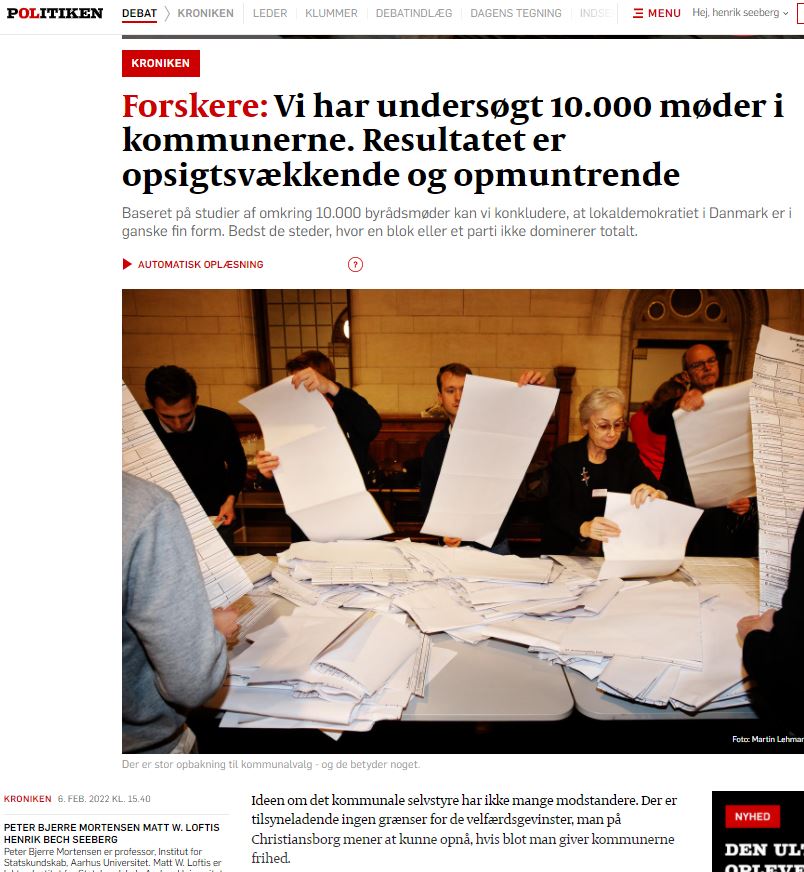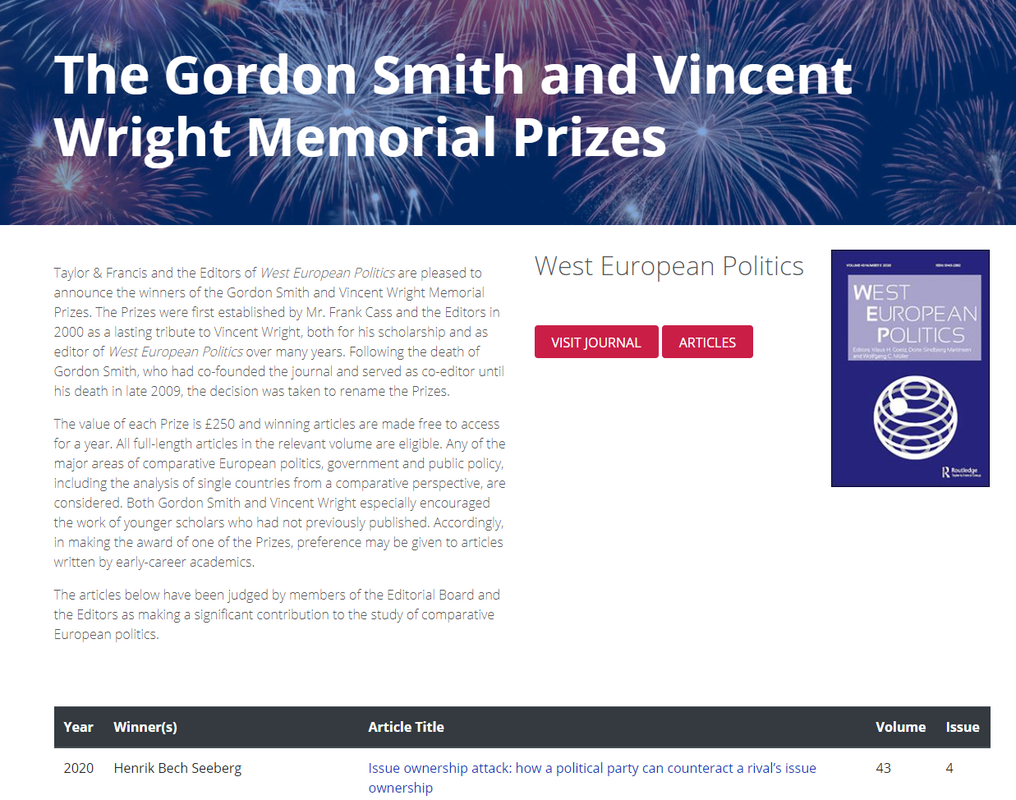|
On 17 June, Danielle May successfully defended her PhD-dissertation (download here), and I had the pleasure to head the assessment committee together with Susan Scarrow (Houston) and Jennifer Hudson (UCL). More info here. Great defense, great day together with fabulous scholars at Dept. of Political Science at Aarhus University!
1 Comment
Stoked to see Tobias Varneskov defend his PhD-thesis on 18 March 2022 with flying colors. Super happy to have been part of this journey and this end-result as his supervisor. Looking forward to the next step where he will join my research group.
Super excited to see that our book has been published. In the book, we collect and content code more than 250,000 agenda items from 10,000 council meetings in the 98 Danish municipalities, 2007-2016 in order to provide a first large-n multi-variate analysis of the key determinants of the policy agenda. Link to the book: https://link.springer.com/book/10.1007/978-3-030-90932-1 The data have been released on our webpage: The Aarhus Research Group on Local Policy Agendas (au.dk) We published a chronicle in the Danish newspaper Politiken on 7 February that offers the key take away messages from the book:
https://politiken.dk/debat/kroniken/art8554765/Vi-har-unders%C3%B8gt-10.000-m%C3%B8der-i-kommunerne.-Resultatet-er-opsigtsv%C3%A6kkende-og-opmuntrende As a fresh perspective on the upcoming local elections in Denmark on 16 November 2021, Danish National radio 'P1 Morgen' covered our book 'Explaining Local Policy Agendas' in an extended prime-time live interview. Thrilled and humble to take part in this! This is a link to the program. The interview takes place at about 7:10am. https://www.dr.dk/lyd/p1/p1-morgen/p1-morgen-2021-11-05
I had the pleasure to review a new book 'The Danish Voter' by Rune Stubager, Kasper M. Hansen, Michael S. Lewis-Beck and Richard Nadeau for Party Politics. I thought I would share my review here. As you will quickly sense, I really liked this book!
Review for Party Politics Rune Stubager, Kasper M. Hansen, Michael S. Lewis-Beck and Richard Nadeau (2021), The Danish Voter: Democratic Ideals and Challenges, Ann Arbor: University of Michigan Press. + 250pp. ISBN 978-0-472-13226-3 / 978-0-472-12833-4. Understanding how voters and voting behavior have changed over the past half-century is one of the major challenges in political science research. The Danish Voter performs an unusually clear, comprehensive and insightful dissection of the development in Denmark since the early 1970s. It encapsulates a period of monumental transition from post-WWII class voting to declining party attachment and increasing issue-based voting in the present day. This book is a must-read for any international scholar who uses Denmark as one among many cases to understand voters and voting behavior in modern democracies. The book offers a 360-degree view of the Danish voter, a comprehensive introduction to the Danish multiparty system and key societal developments, as well as indispensable background information for comparative research on political parties, parliaments, and elections. Stubager, Hansen, Lewis-Beck and Nadeau have amassed and analyzed all Danish national election studies across five decades to forge an exemplary, accessible account that elegantly relies mostly on intuitive graphs of the development in key variables over time. The Danish Voter does not revolutionize our understanding of changes in voters and voting behavior since WWII. Previous work leaves little doubt that sociodemographic voting concerned predominantly with the level of government intervention and redistribution has diminished over time, and new non-economic issues and conflicts have arrived. However, The Danish Voter takes the analysis of this development to another level. The authors take advantage of the lengthier book format (as opposed to the often razor-thin analytical focus of many journal articles) and delivers a rich and nuanced and therefore persuasive and appealing analysis. This allows the authors to arrive at some solid answers about the Danish voter in the past and today. Stubager, Hansen, Lewis-Beck and Nadeau bring together high-quality national election surveys across 17 elections since 1971 in Denmark to tell a fascinating story about how the Danish voter has changed. The analysis applies the Michigan school-inspired ‘funnel of causality’ model, which in this case starts with the impact of sociodemographic variables (age, gender, income, and job category) and adds ideology and lastly opinions about taxation and immigration to the voting-behavior model. The analysis centers on the main division in Danish politics, namely who votes for the leftwing (socialist) vs the rightwing (bourgeois) bloc. The analysis reveals an undeniable downward trend in class voting, driven predominantly by workers (and to some extent low white-collar workers) who no longer vote for the leftwing bloc, whereas self-employed still support bourgeois parties, and high white-collar workers are split. Workers used to vote almost one-sidedly for the Social Democrats, but today, the Liberals and the Danish People’s Party have attracted them in large numbers. In the same vein, ideology no longer explains left- vs. rightwing voting to the same extent, although it remains a core ingredient in the vote choice. The Social Democrats have lost their grip on voters on the left ideological flank, whereas the Liberals have strengthened their hold on ideologically right-off voters. The economy is still important to the vote but less than in the 1980s. Thus, the classic question of a prosperous economy and the right level of redistributions remains relevant, but other concerns have become influential too. This line of inquiry culminates in an analytical crescendo in which the authors vividly demonstrate the central role of issue-based opinions for the Danish voter today. Fascinating cross-time graphs show that the cultural thread of immigration has switched from non-controversial to a core divider in the electorate, while the classic tax-redistribution question remains an evergreen divider. Hence, a new libertarian-authoritarian, cultural dimension of politics has emerged orthogonal to the tax dimension and created a two-dimensional space with great consequences for Danish voters. Stubager et al. reveal a whopping 75 % gap in the leftwing bloc vote between voters who want higher taxes and fewer restrictions on immigration and voters who prefer lower taxes and fewer immigrants. Tellingly, this gap was only about 25 % in the late 1970s but widened particularly in the 1990s when the low-tax-few-immigrants voters almost completely abandoned the leftwing bloc because immigrants became more important than taxes. Again, the analysis indicates that the Social Democrats suffered the hardest hit, while the Danish People’s Party and the Liberals made remarkable progress. Of course, these opinions build on the sociodemographic structure. This speaks to an important point made by the authors: The demise of class-ideology voting does not imply that there is no structure, no social divisions to the vote in Denmark anymore. In fact, the new issue-based voting has a strong sociodemographic underpinning. The main division is increasingly between leftwing-voting, higher-educated, publicly employed urban women who embrace diversity in the urban life and happily pay high taxes to ensure daycare, education and health for their children and rightwing-voting, lower-educated, often privately employed, rural-based men who want to pay less to the state and close the borders. That said, a central insight in the book regarding these conclusions is that relatively speaking, over time, tax and immigrant opinions matter more to the vote, and the social structure, class and ideology less. Such successful deep-dive analysis gives appetite for more. In order to characterize the ‘Danish voter’, a more explicit comparative analysis of the Danish voter vs. voters in other advanced democracies would have been illuminative. It is hard to pin down the peculiarity of the Danish voter by only looking at the Danish voter. To be fair, the authors do refer continuously to studies in other countries. Yet, this does not compare to having both the Danish voter and a reference point in the many nice cross-time graphs. Data for such a reference point is easily available from other national election studies, although it would of course multiply the already impressive data processing exponentially. Moreover, the authors are certainly not blind to the party level, and they do discuss whether parties actually offer a sufficient palette of positions to satisfy the diverse opinions in the electorate. Yet, it is quite a different task to dig into the – admittedly very tricky ‘hen-or-egg’ – question of what explains the described development in the Danish electorate. Did the voters respond to economic changes and immigrant challenges and call for parties to adapt? Or did parties politicize new issues and cut new lines of conflict in the electorate? By not taking parties really into account, the book might tacitly implicate the former, although students of party politics would probably subscribe to the latter. The book offers a perfect steppingstone to venture into this lingering question. Today, I had the privilege to talk to 270 high school pupils at 'Aarhus Katedralskole'. I gave a 90-min online lecture on the causes and consequences of political agenda-setting, primarily in Denmark. We discussed why immigration is such a big issue on the agenda in Denmark and the EU or morality issues such small issues, and we analyzed the politics and political agenda-setting of the covid-19 pandemic.
On Thursday 17 December 2020, I was the chairman of the assessment commitee of Thomas Kristensen's Phd-dissertation at Dept. Political Science at Aarhus University. This was a true honor and I learned a lot from the dissertation. I was lucky to do the assessment with the amazing Frank Baumgartner and Reimut Zohlnhöfer. This was an amazing dissertation on the politics of numbers and how problem indicators influence political parties' attention. Link to download the dissertation: https://politica.dk/politicas-phd-serie/thomas-artmann-kristensen/.
I just received news that I am the winner of the Gordon Smith and Vincent Wright Memorial Prize for the best article published in West European Politics during 2020 for my article: Seeberg, Henrik Bech (2020). ‘Issue ownership attack: How a political party can counteract a rival’s issue ownership’. West European Politics.43(4): 772-794. LINK download. Needless to say, I am of course incredibly happy and proud to have received this prize among so many great publications in this strong journal! Thanks WEP!
More info: https://think.taylorandfrancis.com/journal-prize-the-gordon-smith-and-vincent-wright-memorial-prizes/ I am very pleased to see that my most recent research has been accepted for publication in Party Politics. The manuscript is entitled ‘Avoidance and Engagement in the Electoral Cycle: Selective Emphasis, then Issue Convergence between Political Parties'. Please find a link to download the study on this homepage under publications here. Link to article here: https://journals.sagepub.com/doi/abs/10.1177/1354068820970353
Super excited that my paper co-authored with the fabolous Jonas Lefevere & Stefaan Walgrave has now been published in Political Communication. We study how a party can attack & undermine a rival's issue reputations (performance, priority, and position) as well as cross-effects. More:
https://www.tandfonline.com/doi/abs/10.1080/10584609.2020.1760407?scroll=top&needAccess=true&journalCode=upcp20#.Xs4hzTJrf8k.twitter |
Henrik Bech SeebergPolitical Scientist researching party competition at Aarhus University Archives
April 2023
Categories |










 RSS Feed
RSS Feed
